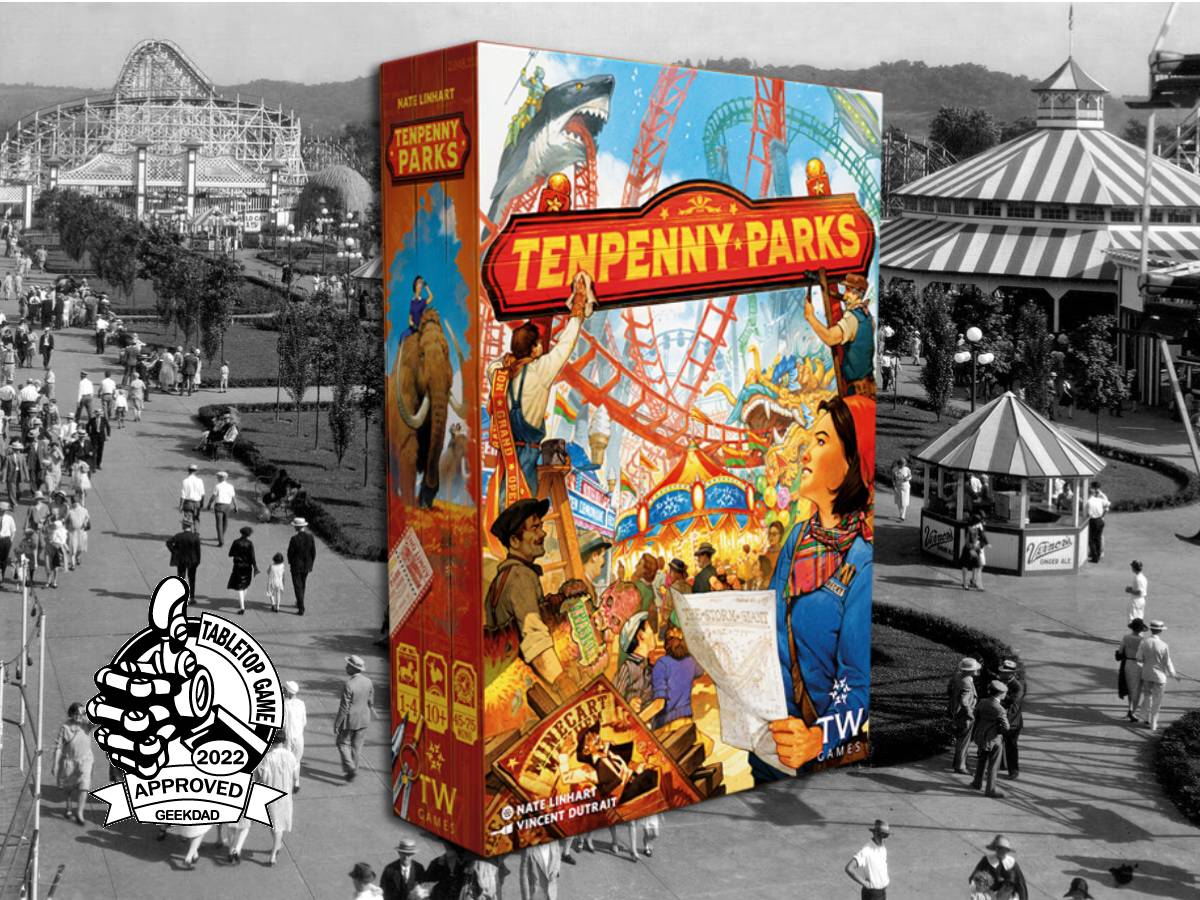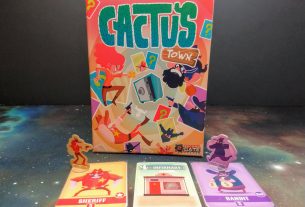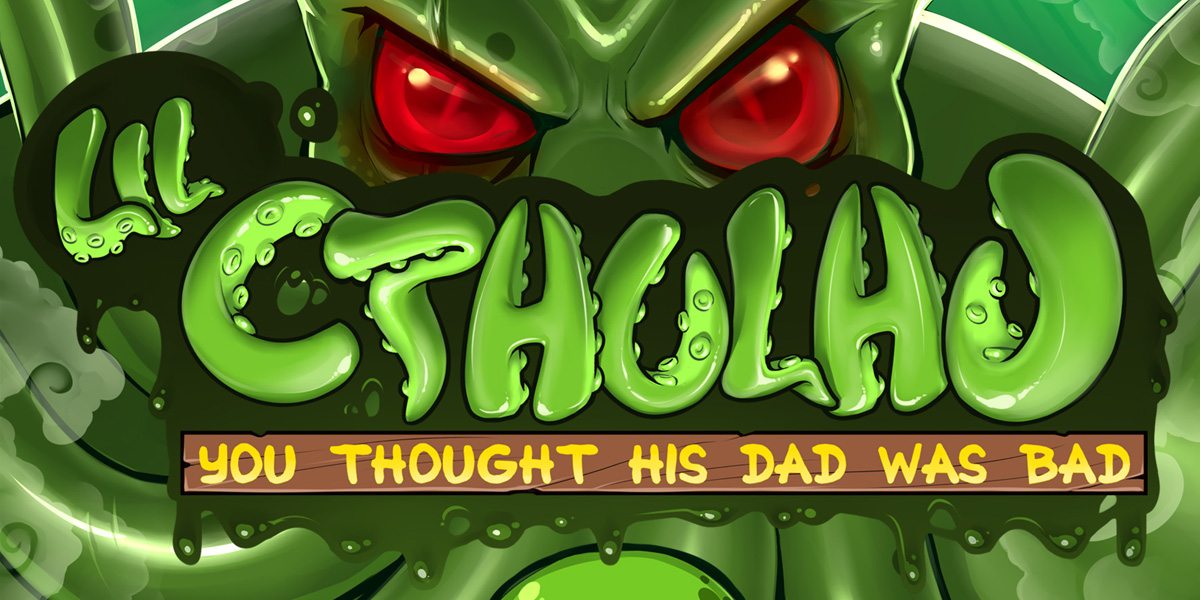Mayor Tenpenny has given you 5 months to make the humble town of Fairview into the home of the world’s greatest theme park. Can you excite the crowds and earn Fairview’s Golden Key?
What Is Tenpenny Parks?
Tenpenny Parks is a game of polyominoes and worker placement for 1-4 players, ages 14 and up, and takes about 45-75 minutes to play. It retails for $59.95, and is currently available to purchase on Amazon or directly from the publisher.
Tenpenny Parks was designed by Nate Linhart and published by Thunderworks Games, with illustrations by Vincent Dutrait.

Tenpenny Parks Components
Inside the box you’ll find:
- Game Board
- 4 double-sided Property Boards
- 12 double-sided Expansion Boards
- 1 Carousel
- 40 Concession Tiles
- 4 Reference Cards
- 35 double-sided Attraction Tiles
- 35 Attraction Cards
- 14 Goal Cards
- 13 Workers
- 12 Emotion Discs
- 50 Tree Markers
- 1 Month Marker
- 1 Shovel Token
- 70 VP Tokens
- 56 Money Tokens
I’ll just say it right at the start: The components from Tenpenny Parks are a delight. The combination of high-quality materials and beautiful artwork by Vincent Dutrait make the game very pleasing on the tabletop.
However, be aware…there is some assembly required!

One of the features of gameplay is a central Carousel, that will be rotated to a new position at the end of each round. It can be a little tricky to assemble the piece; Thunderworks Games even released a video on their website taking you step by step through its construction. But once you’ve put it together, you have a striking three-dimensional structure as part of the game board:

As you can see from that picture, the cardboard used in the game is nice and thick. The Carousel fits neatly into a hole near the top of the game board.
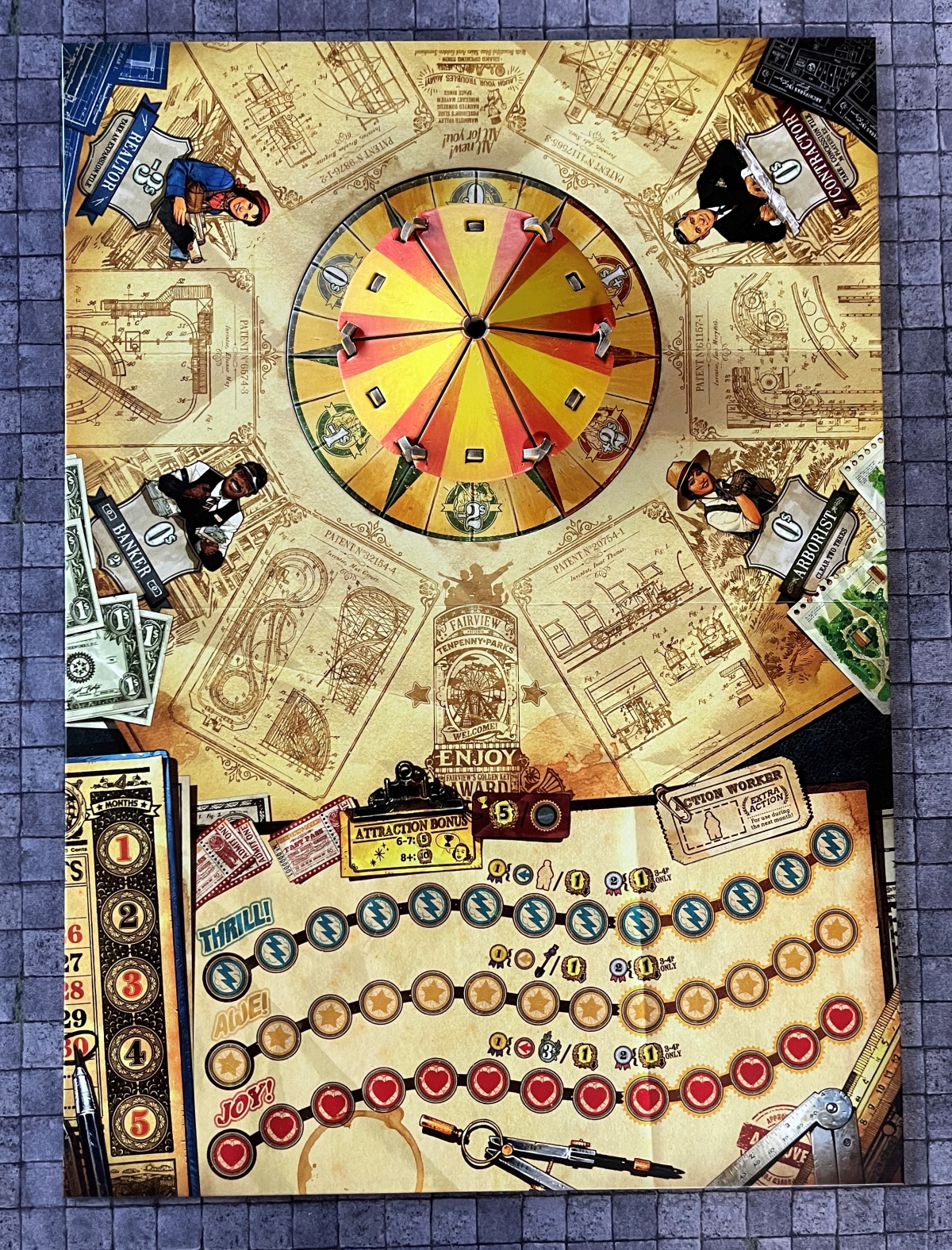
The double-sided player boards, called “Property Boards,” are of the same thick cardboard as the game board and carousel, and have a solid, sturdy feel.

Whenever you take a Property or Expansion Board, you’ll place wooden Tree Markers on each of the tree spaces on the boards.

Each player gets 3 Workers in their chosen player color. I like that each of the colors has its own unique sculpt, rather than just a palette swap. However, I didn’t love the color choices. I would have personally preferred primary colors, though it certainly wasn’t difficult telling the pieces apart on the table.

Instead of going with the ubiquitous coins for in-game currency, in Tenpenny Parks you’re given $1 and $3 bills, made of that same thick cardboard as the other components. The first-player token is the shovel used to break ground on the park.

The attractions that you will purchase and build during the game are represented by two different components. First are the Attraction Cards, which you will purchase during the course of Tenpenny Parks.
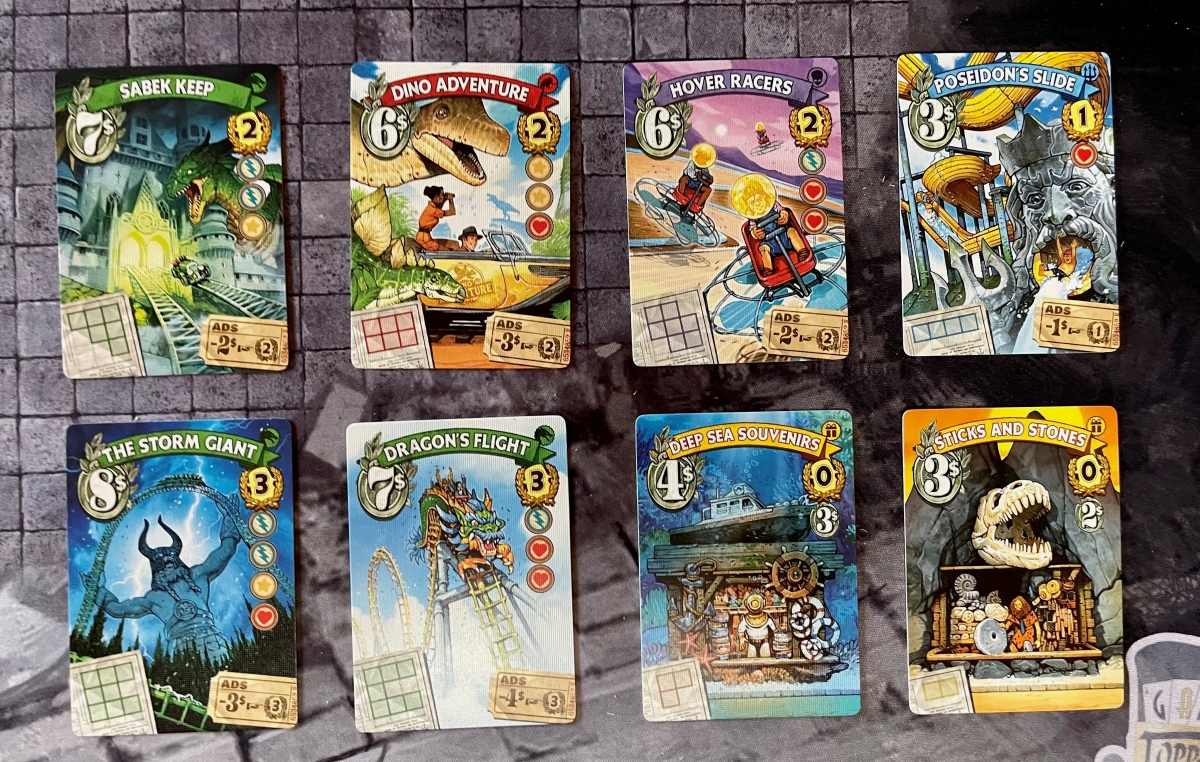
The cards have plenty of information on them, including their cost, benefits they provide, and even a preview of the corresponding tile’s shape so you know before you purchase an attraction whether the tile will fit in your park. However, the information is clear and easy to understand from the iconography.

The Attraction Tiles, like the cards, feature more of the gorgeous Vincent Dutrait artwork.
How to Play Tenpenny Parks
You can download a copy of the rulebook here.
The Goal
The goal of the game is to grow your theme park, making it as attractive to visitors as possible to earn the most VP tokens.
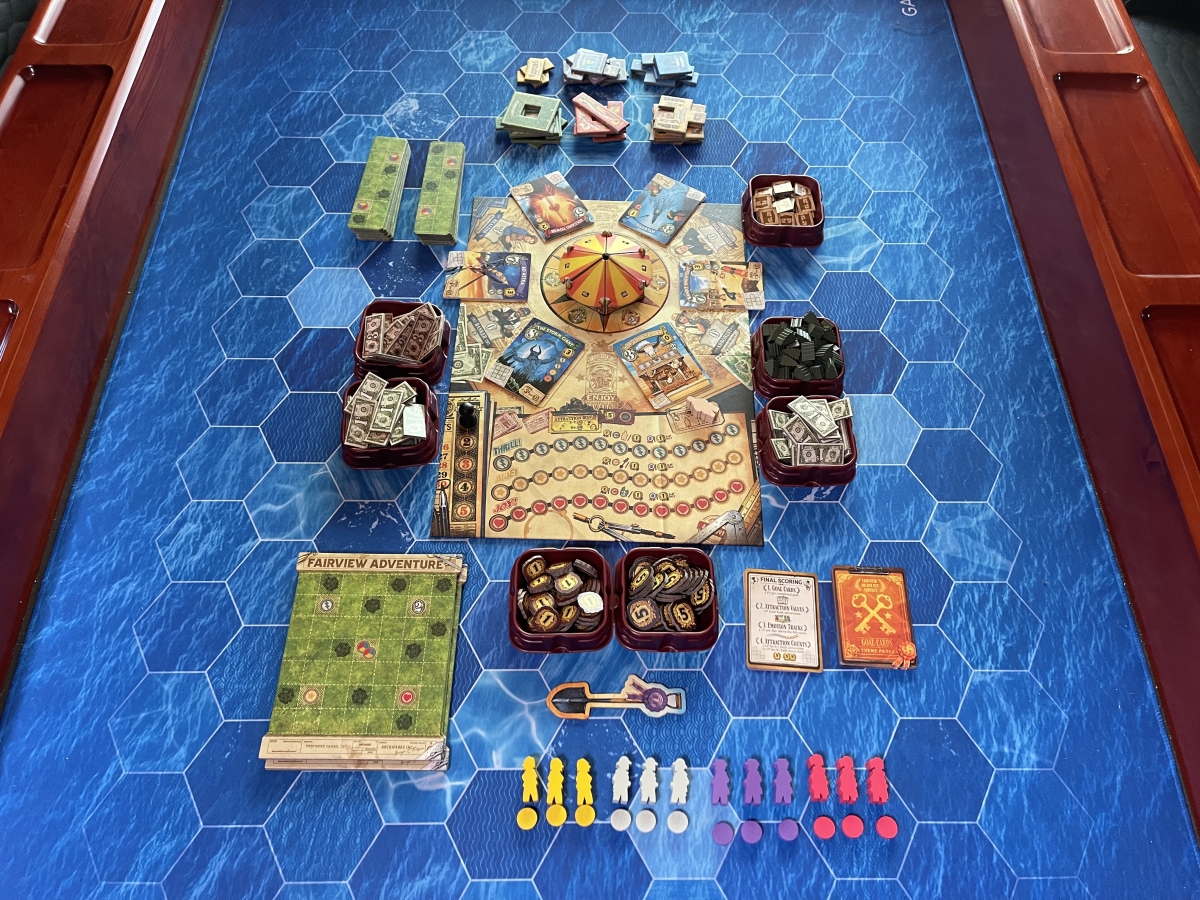
Setup
Place the game board within reach of all the players. Place the Month Marker on the “1” space on the board, and the Extra Action Worker on its designated space.

Place all the Attraction Tiles and Visiting People (VP) tokens within easy reach of all players. Separately shuffle the six types of Attraction Cards, placing each deck face-up on the Attraction spaces around the central opening on the game board.
Insert the Carousel into the central opening, with the “+$2” pointing towards the stack of Souvenir Attraction Cards.
Create piles of supplies, with the Money tokens near the Banker area of the board, two equal piles of Expansion Boards near the Realtor area, face-down Concession tiles near the Contractor area, and the Tree markers near the Arborist area. Reveal a number of Concession tiles equal to twice the number of players.

Give the Shovel token to the player who most recently rode a roller coaster. Shuffle the Goal cards and deal three to each player. Players each choose two to keep, returning the third to the box. These cards are kept secret from the other players.

Starting with the player with the Shovel token and proceeding clockwise, each player will take the following steps:
- Choose a Property board, and place it with either side face-up in front of them. Place Tree markers on each of the spaces indicating trees.
- Choose a player color, and take the matching reference card, workers, and discs.
- Place one disc on the far-left space of each of the three Emotion Tracks.
- Take $7 from the bank.
Gameplay
Gameplay in Tenpenny Parks takes place over 5 months, or rounds. Each month is divided into five steps.
1. Income Step
Each player takes $3 from the supply, as well as any income shown on built concession stands or attraction cards.
2. Actions Step
Starting with the player with the Shovel token and proceeding clockwise, each player will place one worker on an action space of the board and immediately take that action. Note: all action spaces can hold any number of player’s workers, except for the Builder spaces.
These are the action spaces:
- Builder. Pay the cost shown on the associated Attraction card, plus or minus the modifier shown on the Carousel ring. Take the matching Attraction tile, and place it onto your Property board following placement rules. Additionally, advance on any of the Emotion Tracks matching the icons on the Attraction card.
- Banker. Take $2 from the bank.
- Arborist. Remove up to two Tree markers from your Property board.
- Contractor. Take one of the face-up Concession tiles and place it on your Property board following placement rules. Additionally, advance on any of the Emotion Tracks shown on the Concession tile.
- Realtor. Pay $3 to purchase one of the double-sided Expansion boards from the top of either of the two stacks. Align the board to either side of the Property board, and then add Tree markers to any indicated tree spaces. You may add any number of Expansion boards throughout the game.

Tile Placement Rules
Attraction and Concession tiles may touch diagonally, but cannot be adjacent to each other. They may be adjacent to tree markers. They cannot overlap existing markers, or hang over the board.
If a tile is placed over a money icon, you will immediately gain that amount from the bank. If placed over an Emotion Track icon, you will immediately advance as many spaces on that track as there are icons. Wild icons allow movement on any of the tracks.

Moving on Emotion Tracks
If there are multiple discs on the track where you are moving, remove your disc while maintaining the order of the remaining discs. If you move your disc into a space with other discs, your disc will go on top of that stack.
3. Bonuses Step
The person farthest along on each Emotion track will choose between either moving their disc back one space on the track to take the special action, or remaining where they are and taking 1 VP token. If there are two or more tracks in the farthest space, then the disc on top counts as being farthest. In a 3 or 4 person game, the 2nd place player on each track will receive 1 VP.
Special Actions
- Thrill track. Take the Extra Action worker for use in the next round.
- Awe track. Take the Shovel token, and you will rotate the Carousel ring during the Cleanup step.
- Joy track. Take $3.

4. Advertising Step
Simultaneously, each player optionally pays the amounts indicated on any or all of their Attraction cards to advertise their attractions, receiving the corresponding VP tokens shown on the cards.
5. Cleanup Step
- Refresh the Concessions. Return any unclaimed Concession tiles to the game box, and then place face-up a number of Concession tiles from the supply equal to twice the number of players.
- Return all Workers. Players retrieve all of their Workers.
- Rotate the Carousel. The player with the Shovel token rotates the Carousel to a new position.
- Advance the month. The Month marker is moved to the next space. If it is already in the fifth space, then proceed to game end. Otherwise, go back to Step 1.
Game End
Once the fifth month is complete, then players will tally final scores:
- Goals. For each completed Goal card, the player takes 3 VP tokens.
- Attractions. Each player takes VP tokens equal to those shown on all of their Attraction cards.
- Emotion Bonuses. Each player takes 5 VP tokens for each of their Emotion discs that ended farther than the eighth space on each of the Emotion Tracks.
- Attraction Count Bonus. Each player that has six or seven Attraction cards takes 5 VP tokens. Each player with eight or more Attraction cards takes 10 VP tokens.
Players then add up all of their VP tokens, and whoever has the most, wins!
Solo Mode
There are dedicated solo rules included for playing a single-player game. You play against an automata opponent, “Becky,” that follows a set pattern of behavior for each of the steps in a month. You can read the exact solo rules here.
Tenpenny Parks is a 2022 GeekDad Game of the Year Finalist!
Why You Should Play Tenpenny Parks
I have to admit, I’m a sucker for a game with good table presence. It’s why I’m attracted to games with nice miniatures like you find in all of those different CMON Kickstarter campaigns. And while Tenpenny Parks certainly isn’t a huge box full of plastic, it does look great on the table, thanks in no small part to Vincent Dutrait’s artwork. On a podcast I was listening to recently, I heard Dutrait referred to as “the Norman Rockefeller of the board game world,” and from looking at his work on this game, I’d have to agree. Tenpenny Parks is also full of high-quality components, from the dozens of wooden pieces to the highly thematic three-dimensional Carousel which changes the costs of purchasing attractions each round.
Of course, no eye candy in the world is going to save a bad game. And I’m happy to announce that Tenpenny Parks is, in fact, a very fun and engaging board game. It’s a bit of a point salad, in that there are multiple ways to earn VP throughout the game. Advancing on the Emotion tracks, acquiring Attractions, fulfilling Goal cards, advertising Attractions…all of these will net you different amounts of VP.
None of the ways to earn VP exist in a vacuum, either. Almost every choice you make will have repercussions that affect your game. One of my Goal cards awarded me bonus VP for having at least 3 of the “Undersea”-themed Attractions. In order to acquire those, I’d have to have enough money to afford them, as well as spaces in my park that would fit them. I chose to focus on advancing early on the Awe track, which awards the Shovel token. With the Shovel token, I could move the Carousel at the end of a round so that the Undersea Attraction would be the cheapest to purchase on the next round. I would also be placing a Worker first on the next round, ensuring that I’d be able to buy that Attraction that I’d just discounted.
Managing your Property board and determining where to place your Attraction and Concession tiles is just as important as determining which Attractions to purchase. While you’ll want to cover up the icons on your board for their various bonuses, you risk focusing on that to the detriment of maximizing tile placement. Thankfully, if your placement turns out to be less than optimal, on your turn you can always purchase Expansion boards or clear trees. But being forced into doing that as a result of your earlier decisions can cause you to miss out on other opportunities. Being able to purchase an Attraction at the top of a round is useless if you don’t have the current space to place the Attraction tile.

There were a couple of small quibbles I had with the game, but nothing major. Because some Concessions and Attractions have dollar amounts printed on them in the same area where you find Emotion icons, there was repeated confusion with players as to when you actually receive that money (it’s only during the Income step). Also, moving the wooden Emotion discs on the Emotion tracks while maintaining the proper order in stacks would often turn into a mini-dexterity game. Which, if you think about it, is somewhat appropriate to the theme for Tenpenny Parks, but probably not what designer Nate Linhart was intending.
Thanks to the shuffling of Attraction and Goal cards each game, there’s a lot of replayability in Tenpenny Parks. There is no one clear path to victory, and a willingness to alter your strategies will serve you well in the game. While the Goal cards can give you something to work for, the fact that each one is only worth 3 VP makes it unlikely that following them will decide whether you win or lose. For example, in one game I played, I met both of my goals and came in second, while another player only fulfilled one goal, yet still beat me.
The game length of 5 rounds (or months) feels like the perfect length. There’s enough time to get a satisfying park built, but not so much that the game drags out. And each of those months plays out at a snappy pace.
While there are a lot of choices to make, there’s enough flexibility that Tenpenny Parks is pretty forgiving. I never felt like my success or failure was determined by playing flawlessly each turn. Additionally, there were very few moments where anyone at the table became trapped in periods of analysis paralysis. Tenpenny Parks will certainly have you thinking, but it’s never overwhelming. Full of family-friendly strategic fun, Tenpenny Parks is an inviting presence on your game table and doesn’t overstay its welcome.
For more information, head over to Thunderworks Games’ Tenpenny Parks page.
Click here to see all our tabletop game reviews.
![]() To subscribe to GeekDad’s tabletop gaming coverage, please copy this link and add it to your RSS reader.
To subscribe to GeekDad’s tabletop gaming coverage, please copy this link and add it to your RSS reader.
Disclosure: GeekDad received a copy of this game for review purposes.
